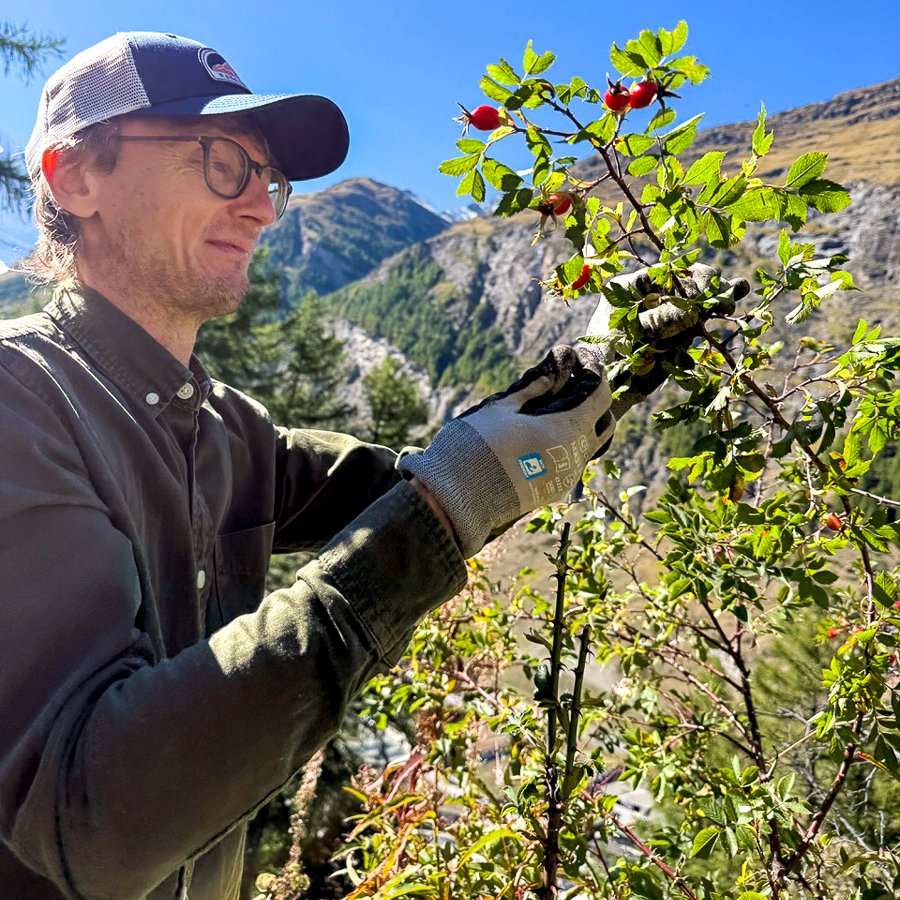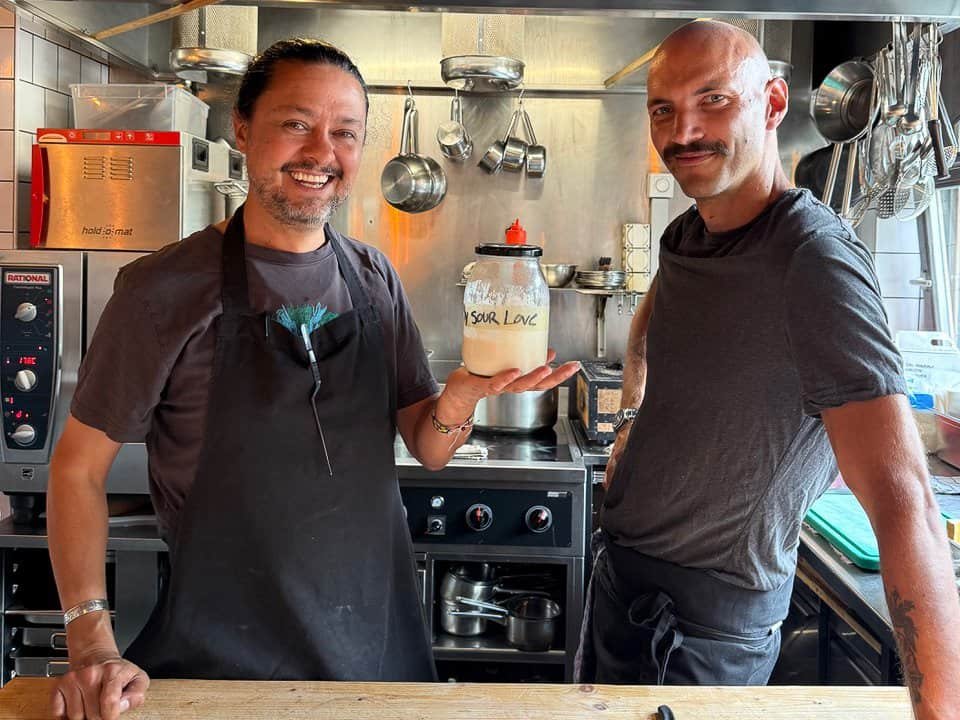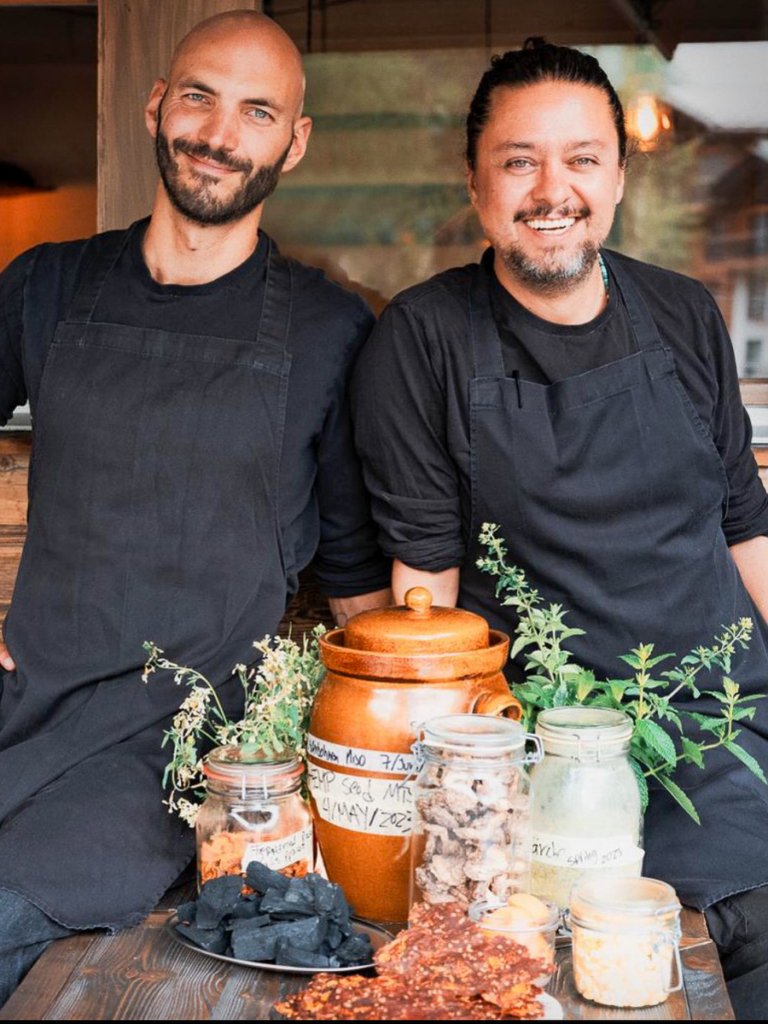Brasserie Uno Zermatt | How Andreas Alm Created a Michelin-Starred Restaurant Rooted in Sustainability
Tucked away in the beautiful mountain town of Zermatt, Brasserie Uno is the kind of place that makes you feel instantly at home—if your home also happened to serve up some of Switzerland’s most exciting food.
At the heart of it all is Andreas, a Swedish engineer-turned-restaurateur who followed his love of skiing and good food to the Alps. In our chat, Andreas opens up about how one ski season led to a whole new life, why sustainability is the backbone of everything they do, and how Brasserie Uno strives for flavour, fun, and a truly unique dining experience.
Whether you’re a foodie, a sustainability nerd, or just love a good story, you’ll want to hear how this little spot with big ideas landed its Michelin stars and what’s next for the team.

Discover Zermatt contains affiliate links, if you make a purchase using one of these links, we may receive compensation at no extra cost to you. Read our disclaimer for more information.
Personal & Background
Can you tell me about your journey—what brought you to Zermatt, and how Brasserie Uno came to life?
I am originally from Sweden, and I studied engineering in Stockholm, completed my degree, and then wanted to do something else for a year. So, I decided to cycle from Stockholm to Zermatt to do ski a season.
I completed one season and then returned to Sweden for the summer. I quickly realised I really wanted to be in Zermatt. So, I came back to stay indefinitely. I worked in different bars and restaurants, built houses in the summers, and tried all kinds of different jobs.
In 2010, I got the location we have now and started a restaurant called The Bubble with two English guys, which we ran together for about seven and a half years. We wanted to go in different creative directions, and in December 2018, I opened Brasserie Uno.
What was the inspiration behind the name Brasserie Uno?
On a train to Amsterdam, I Googled synonyms for “restaurant” and “brasserie” came up. Brasserie, in French, means brewery. And my granddad, Uno, worked at a brewery in Sweden. So that’s how the name came together. Brasserie Uno.
Booking Your Holiday?
Use our favourite travel resources to save time & money:
Best Accommodation Deals
Save on Swiss Train Travel
Affordable Airport Transfers
Excellent Tours & Activities
The best Flight Deals
Save on Car Hire
Don’t forget Travel Insurance
Food Philosophy & Menu

Where did the inspiration come from for the type of food you serve here?
I said from the very beginning that I wanted to do something different for Zermatt. I was happy to do classic dishes, but they had to have a very specific twist, and I wanted to work with a lot of local and seasonal products.
Our head chef, Luis Romo, has been with us since the beginning. He is Mexican, but we work with a global flavour profile, primarily using Swiss products. We talk a lot about food and travel, and inspiration from all kinds of places.
You’re known for using seasonal and locally sourced ingredients—can you walk us through how that influences your menu planning?
The whole team constantly discusses the menu and food in general, and while the sous chef, Tommaso Guardascione and I have lots of ideas, in the end, Luis has the final word. We change one dish at a time, not the whole menu.
Then, we try to find local, high-quality, sustainable products and work with each one. And then we use it, or order it, as long as we can, and make sure that we really use everything from nose to tail.
We also have three gardens in Zermatt, where we grow our own ingredients, and friends who know our philosophy often bring any excess they have. So we may have enough for a few evenings or a few weeks, but when it’s gone, it’s gone. Our menu is ever-evolving.
Do you have a favourite dish on the current menu or one that has a special story behind it?
We actually have one dish that was a constant throughout the entire winter season. We did a version of it last year and developed it into what it is today. It’s such a hit, so we wanted to keep it on the menu. It’s a celeriac parfait with a foam made from mascarpone, accompanied by olive oil and sturgeon caviar. Pretty much everyone loves it.
Has it been a challenge to maintain high culinary standards while also staying sustainable?
Nothing is easy, but sustainability comes first. We keep high standards and sustainability by keeping the numbers manageable. If we accepted last-minute bookings or walk-ins, we could do more covers, but then we’d have to buy extra food for this possibility and likely have more food waste.
The Experience at Uno


What is Uno’s philosophy, and what differentiates you from other restaurants in Zermatt?
Our main philosophy is sustainability, not only in the food we serve but also in the way we manage food waste, water usage, electricity usage, staff and other environmental considerations. We ask the guests to keep their cutlery throughout the menu, so we don’t change cutlery after every dish; this saves on water usage.
We strive to minimise food waste as much as possible, so we only prepare food for the number of guests booked for that night. All of our bookings are made online, and we require special dietary requirements to be submitted the day before. If we have any last-minute booking requests, I need to check with the kitchen to see if it is possible.
We also make sure the staff have two days off and don’t work overtime. We try to maintain a stress-free environment. Because of this, we tend to keep the same team; we have a low staff turnover rate.
The interior has lots of mementos from Uno, and also recycled and repurposed products. We had some recent guests who said, “Thank you very much for sharing your living room”. That’s the kind of experience we’re going for.
I absolutely love your crockery. Where did the idea for the blue and white tableware originate?
The idea behind all the crockery is from Uno’s wife, my grandma, who gave me some old, beautiful porcelain crockery. And I thought, why not take care of what’s already produced and reuse it?
In 2018, I took a three-month road trip around Sweden with my Australian girlfriend to build up the concept of Brasserie Uno. We drove around and visited numerous secondhand stores, choosing a theme of blue and white china, and bought everything.
Dining at UNO is often described as intimate and creative. What kind of experience are you hoping guests to walk away with?
We strive to educate our guests during their visit, explaining our philosophy, what they are eating, and how we utilise ingredients, in the hope that we inspire them to think about sustainability when they cook.
And, of course, we hope they enjoy the food and appreciate all the hard work that goes into creating a unique dining experience.
Awards & Challenges


What awards or recognitions have you received recently?
We have a Michelin Red Star, which is for the quality of the food. We also have a Michelin Green Star for our sustainability efforts.
What would you say is your greatest challenge?
I would say our biggest challenge is meeting people’s expectations. We are not a classic Michelin-starred restaurant; we don’t have a dress code, tablecloths, or servers wearing gloves. We are a rustic, casual experience. We want people to relax in a cosy environment, where all the focus is on the food.
There is no à la carte menu, no kids’ menu, our experience takes three and a half hours, and the only choice you have is your drink order. We require all special requests, such as intolerances, vegetarian, or gluten-free, to be submitted the day before.
Sometimes, guests may not see this information on our website when booking, and it can be challenging to cater to their needs on the night.
How do seasonal changes and tourism situations affect your operations?
From Christmas to the end of March is high season, which we can generally count on, helping with our food waste management. We close during May and mid-October to mid-November during the low season.
The rest of the year is less predictable, and we get many last-minute bookings. In these months, we have to be reactive to each day and the fluctuating guest numbers to maintain high standards and sustainability.
Now & The Future

Where do you see Brasserie Uno in the next few years? Are there any ideas or projects that you’re excited about?
Over the years, we have figured out what works best for us financially and sustainably. We have been constantly developing, and change is good because otherwise, things get boring.
Our next project is to bring in international guest chefs. They will tell us what they want to cook, and we will tell them if it is possible using locally sourced, sustainable ingredients.
Aside from Uno, where are your favourite places to dine in Zermatt?
I enjoy eating at La Mũna; the food is delicious there. I like 1818, and recently, I went to eat at Hotel Carina, which has just changed its chef, a fact not many people are aware of, and the food was fantastic.
On the mountain, Findlerhof and Marmo have excellent lunch options.
Brasserie Uno Zermatt – Not Your Average Michelin-Starred Restaurant
Brasserie Uno is more than just a restaurant—it’s a reflection of Andreas’s journey, ideals, and love for food that tells a story. From humble beginnings, Andreas and his team have created a place where sustainability isn’t just a buzzword, but the very heart of their kitchen.
Their hands-on approach, genuine hospitality, and commitment to local ingredients make Brasserie Uno stand out among Zermatt’s dining options.
Whether you’re a regular guest or a curious newcomer, you’ll find something memorable—not just on your plate, but in the atmosphere, the team, and the stories they’re eager to share.
If you’re heading to Zermatt, make sure Brasserie Uno is on your list. It’s proof that great food, good company, and a little bit of mountain magic make for the best kind of dining experience.
Plan Your Perfect Trip to Zermatt
Ready to dive deeper into planning your visit?
Our essential guides help make the most of your time in the mountains.
Getting Here
Trains, transfers & travel tips
Where to Stay
The best hotels, chalets & apartments
What to Do
Skiing, hiking & year-round activities
Where to Eat
Restaurants, fondue & hidden gems
Zermatt FAQs
Everything you need to know